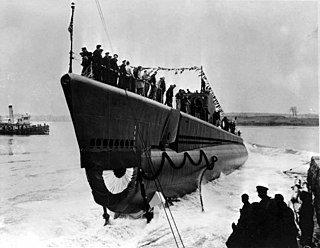
USS Skate (SS-305) was a Balao-class submarine in service with the United States Navy from 1943 to 1946. She was used as a target ship in the 1946 atomic bomb tests and finally sunk as a target ship in October 1948.

USS Grayback (SS-208), a Tambor-class submarine, was the first ship of the United States Navy to be named for the lake herring, Coregonus artedi. She ranked 20th among all U.S. submarines in total tonnage sunk during World War II, with 63,835 tons, and 24th in number of ships sunk, with 14. She was sunk near Okinawa on 27 February 1944. Her wreck was discovered in June 2019.

USS Harder (SS-257), a Gato-class submarine, was the first ship of the United States Navy to be named for the Harder, a fish of the mullet family found off South Africa. One of the most famous submarines of World War II, she received the Presidential Unit Citation. Her commanding officer throughout her service, the resolute and resourceful Commander Samuel D. Dealey (1906–1944), "a submariner's submariner", was posthumously awarded the Medal of Honor, as well as four Navy Crosses during his lifetime.

USS Sturgeon (SS-187), a Salmon-class submarine, was the second ship of the United States Navy to be named for the sturgeon. Her 1944 sinking of the Japanese troopship Toyama Maru, killing more than 5,000 Japanese, was one of the highest death tolls from the sinking of a single ship in history. Her 1942 sinking of the Montevideo Maru which, unknown to crew on the Sturgeon, was carrying over 1,000 POWs, was the worst maritime disaster in Australian history.

USS Greenling (SS-213), a Gato-class submarine, was the first ship of the United States Navy to be named for the greenling.

USS Shad (SS-235), a Gato-class submarine, was the first submarine and second vessel of the United States Navy to be named for the shad, a fish of the herring family, common along coasts of the United States.

USS Bream (SS/SSK/AGSS-243), a Gato-class submarine, was the first ship of the United States Navy to be named for the bream. She served during World War II, and her war operations extended from 1 June 1944 to 15 June 1945. During this period she completed six war patrols operating in the Java Sea, Celebes Sea, Sulu Sea, South China Sea, and Gulf of Siam. She sank two Japanese merchant ships totaling 6,934 gross register tons. In addition, Bream shared with the submarines USS Ray (SS-271) and USS Guitarro (SS-363) the destruction of a 6,806-gross register ton passenger-cargo ship. On 23 October 1944, while patrolling off western Luzon, Bream made a daring surface attack on a Japanese naval force, damaging the heavy cruiser Aoba.

USS Pogy (SS-266), a Gato-class submarine, was the first ship of the United States Navy to be named for the pogy, or menhaden. She was credited with sinking 16 ships totaling 62,633 gross register tons during World War II.

USS Rasher (SS/SSR/AGSS/IXSS-269), a Gato-class submarine, was a ship of the United States Navy named for the rasher, or vermilion rockfish, a fish found along the California coast.

USS Raton (SS/SSR/AGSS-270), a Gato-class submarine, was a ship of the United States Navy named for the raton, a polynemoid fish inhabiting semitropical waters off the Pacific coast of the Americas.

USS Balao (SS/AGSS-285) was the lead ship of the United States Navy's Balao-class submarines during World War II and named for the balao, a small schooling marine fish.

USS Seahorse (SS-304), a Balao-class submarine, was the first submarine and second ship of the United States Navy to be named for the seahorse, a small fish whose head and the fore part of its body suggest the head and neck of a horse.

USS Aspro (SS/AGSS-309), a Balao-class submarine, was the first ship of the United States Navy to be named for the aspro, a fish found abundantly in the upper Rhône River. According to legend, the aspro comes to the surface only in bad weather, when other fishes take refuge near the bottom. This trait gave rise to its nickname, "Sorcerer."

The first USS Batfish (SS/AGSS-310) is a Balao-class submarine, known primarily for the remarkable feat of sinking three Imperial Japanese Navy submarines in a 76-hour period, in February 1945. USS Batfish is the first vessel of the United States Navy to be named for the batfish, a type of anglerfish that crawls about on the sea floor.

USS Baya (SS/AGSS-318), a Balao-class submarine, was a ship of the United States Navy named for the baya. During World War II, she completed five war patrols in the South China Sea, Gulf of Siam, Java Sea, and Philippine Sea between 23 August 1944 and 25 July 1945. She sank four Japanese vessels totaling 8855 gross register tons, and shared credit with the submarine USS Hawkbill (SS-366) for sinking a Japanese 8,407-gross register ton passenger-cargo ship. After World War II, she saw service as a research submarine during the Cold War and operated off Vietnam during the Vietnam War.

The first USS Parche (SS-384/AGSS-384) was a United States Navy submarine. She bore the name of a butterfly fish, Chaetodon capistratus. Parche was a Balao-class submarine that operated in World War II.

The first USS Spadefish (SS/AGSS-411), a Balao-class submarine, was the first ship of the United States Navy to be named for the spadefish. Although she was commissioned late in the war and spent only one year in the Pacific war zone, she was able to run up a record of 88,091 tons in 21 ships and numerous trawlers sunk.

USS Hawkbill (SS-366), a Balao-class submarine, was the first ship of the United States Navy to be named for the hawksbill, a large sea turtle.

USS Pintado (SS-387/AGSS-387), a Balao-class submarine, was the first ship of the United States Navy to be named for the pintado.

Asashimo was a Yūgumo-class destroyer of the Imperial Japanese Navy. She was among the several ships sunk during Operation Ten-Go by attacking US aircraft in 1945.




















